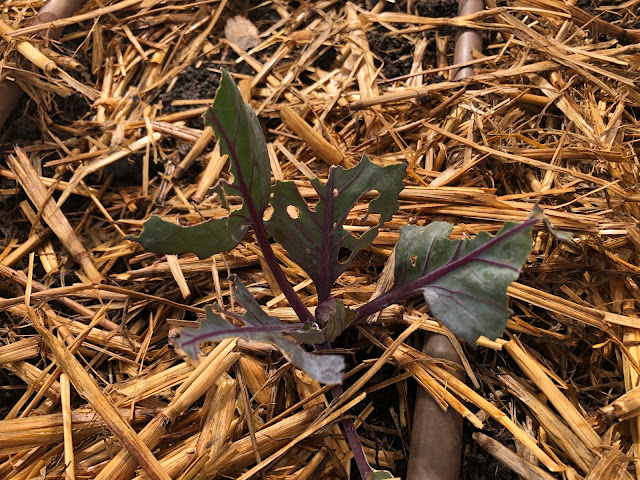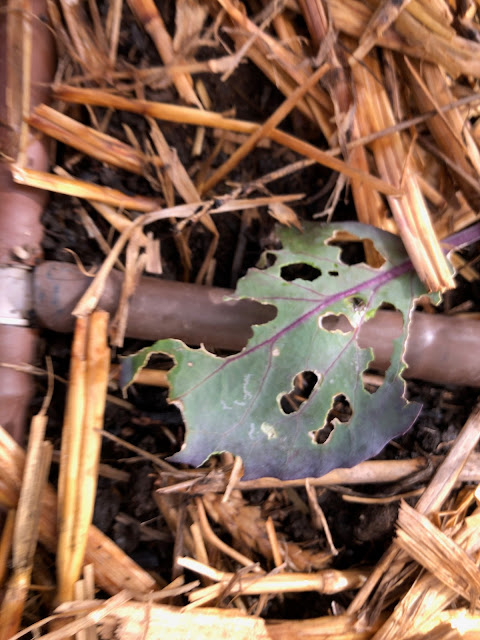
Don’t fret: It’s cooler, so things actually aren’t too bad

|
|
Most of the damage to this plant at the Fair Oaks Horticulture Center was caused by birds, says master gardener Gail Pothour. The leaves are eaten along the edges. (Photos: Kathy Morrison)
|
The oranges are splitting again. The new lettuce disappeared overnight. The carrots still aren’t sprouting. Help! Who decided that fall was an easy time to garden?
Take a deep breath. Notice the air — it’s cooler in the morning, isn’t it? Even the afternoons are better. Little spikes into the low 90s are much easier to handle than, oh, 112 degrees. Right? OK, then. Relax.
But fall does have its challenges. Here are five, and how to deal with them (or at least explain them):

|
|
Same plant as above, but a different leaf and likely different pest for most
of the damage: Caterpillars sit on the ribs and eat the leaf centers. |
Caterpillar pests crawl along the ribs of the leaves and take chunks out of the middle. At worst, they crawl down inside the heads of the developing vegetables where they can't be reached. So catch them early, if you have an outbreak. Row covers will keep the butterflies from laying eggs on the plants. Bt, short for bacillus thuringiensis, is an excellent bacteria-based caterpillar fighter.
2. Disappearing sprouts or transplants. If you see damage along the edges of the vegetable leaves, suspect birds, Pothour says. Young, fresh plants look good to them, too. Birds will sit on the soil next to the plant to feast, and can eat it down to the ground if it's young. To keep birds off the young plants, try row covers, mesh baskets or the like. Just be sure to anchor those covers so the birds can't get underneath.
3. Sprouts not appearing at all. Did you plant carrots? For such a common vegetable, they take a long time to germinate. Weeks, in fact. Be patient. Then when they do sprout and get to be about 2 inches tall, don't forget to thin them. They need space to grow. And if you're planting beets or chard, rinse the seeds first, Pothour advises. This removes a chemical on the seeds that inhibits germination. Incidentally, the master gardeners have published a great guide to growing beets .
4. Oranges splitting. This has become more of a Northern California problem in October just the past few years. It's not a disease. Basically, spikes in warm weather and lack of irrigation together signal the tree to suck some moisture out of the fruit. The fruit wall weakens. Then when the tree gets more moisture from rain or irrigation, it sends it back, bursting the weakened fruit. I wrote a full blog post on this problem last year. I've lost only two oranges to splitting so far this year, thank goodness.
5. Perennials looking ragged. Perennials tend to be leggy in late summer, and can be pruned or cut down now, especially if you see new sprouts forming at the base of the plant. Even if you don't see any, it's a good time to clean them up. Perennial herbs can use a good fall haircut, too.
Comments
0 comments have been posted.Sacramento Digs Gardening to your inbox.
Sites We Like
Garden Checklist for week of July 21
Your garden needs you!
* Keep your vegetable garden watered, mulched and weeded. Water before 8 a.m. to reduce the chance of fungal infection and to conserve moisture.
* Feed vegetable plants bone meal, rock phosphate or other fertilizers high in phosphate to stimulate more blooms and fruiting. (But wait until daily high temperatures drop out of the 100s.)
* Don’t let tomatoes wilt or dry out completely. Give tomatoes a deep watering two to three times a week.
* Harvest vegetables promptly to encourage plants to produce more. Squash especially tends to grow rapidly in hot weather. Keep an eye on zucchini.
* Pinch back chrysanthemums for bushy plants and more flowers in September.
* Remove spent flowers from roses, daylilies and other bloomers as they finish flowering.
* Pinch off blooms from basil so the plant will grow more leaves.
* Cut back lavender after flowering to promote a second bloom.
* It's not too late to add a splash of color. Plant petunias, snapdragons, zinnias and marigolds.
* From seed, plant corn, pumpkins, radishes, winter squash and sunflowers.